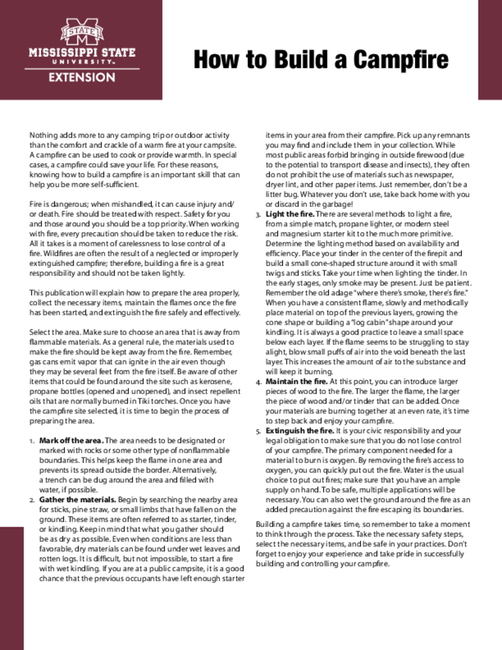How to Build a Campfire
Nothing adds more to any camping trip or outdoor activity than the comfort and crackle of a warm fire at your campsite. A campfire can be used to cook or provide warmth. In special cases, a campfire could save your life. For these reasons, knowing how to build a campfire is an important skill that can help you be more self-sufficient.
Fire is dangerous; when mishandled, it can cause injury and/or death. Fire should be treated with respect. Safety for you and those around you should be a top priority. When working with fire, every precaution should be taken to reduce the risk. All it takes is a moment of carelessness to lose control of a fire. Wildfires are often the result of a neglected or improperly extinguished campfire; therefore, building a fire is a great responsibility and should not be taken lightly.
This publication will explain how to prepare the area properly, collect the necessary items, maintain the flames once the fire has been started, and extinguish the fire safely and effectively.
Select the area. Make sure to choose an area that is away from flammable materials. As a general rule, the materials used to make the fire should be kept away from the fire. Remember, gas cans emit vapor that can ignite in the air even though they may be several feet from the fire itself. Be aware of other items that could be found around the site such as kerosene, propane bottles (opened and unopened), and insect repellent oils that are normally burned in Tiki torches. Once you have the campfire site selected, it is time to begin the process of preparing the area.
- Mark off the area. The area needs to be designated or marked with rocks or some other type of nonflammable boundaries. This helps keep the flame in one area and prevents its spread outside the border. Alternatively, a trench can be dug around the area and filled with water, if possible.
- Gather the materials. Begin by searching the nearby area for sticks, pine straw, or small limbs that have fallen on the ground. These items are often referred to as starter, tinder, or kindling. Keep in mind that what you gather should be as dry as possible. Even when conditions are less than favorable, dry materials can be found under wet leaves and rotten logs. It is difficult, but not impossible, to start a fire with wet kindling. If you are at a public campsite, it is a good chance that the previous occupants have left enough starter items in your area from their campfire. Pick up any remnants you may find and include them in your collection. While most public areas forbid bringing in outside firewood (due to the potential to transport disease and insects), they often do not prohibit the use of materials such as newspaper, dryer lint, and other paper items. Just remember, don’t be a litter bug. Whatever you don’t use, take back home with you or discard in the garbage!
- Light the fire. There are several methods to light a fire, from a simple match, propane lighter, or modern steel and magnesium starter kit to the much more primitive. Determine the lighting method based on availability and efficiency. Place your tinder in the center of the firepit and build a small cone-shaped structure around it with small twigs and sticks. Take your time when lighting the tinder. In the early stages, only smoke may be present. Just be patient. Remember the old adage “where there’s smoke, there’s fire.” When you have a consistent flame, slowly and methodically place material on top of the previous layers, growing the cone shape or building a “log cabin” shape around your kindling. It is always a good practice to leave a small space below each layer. If the flame seems to be struggling to stay alight, blow small puffs of air into the void beneath the last layer. This increases the amount of air to the substance and will keep it burning.
- Maintain the fire. At this point, you can introduce larger pieces of wood to the fire. The larger the flame, the larger the piece of wood and/or tinder that can be added. Once your materials are burning together at an even rate, it’s time to step back and enjoy your campfire.
- Extinguish the fire. It is your civic responsibility and your legal obligation to make sure that you do not lose control of your campfire. The primary component needed for a material to burn is oxygen. By removing the fire’s access to oxygen, you can quickly put out the fire. Water is the usual choice to put out fires; make sure that you have an ample supply on hand. To be safe, multiple applications will be necessary. You can also wet the ground around the fire as an added precaution against the fire escaping its boundaries.
Building a campfire takes time, so remember to take a moment to think through the process. Take the necessary safety steps, select the necessary items, and be safe in your practices. Don’t forget to enjoy your experience and take pride in successfully building and controlling your campfire.
Publication 3277 (10-22)
Reviewed by Reid Nevins, Extension Specialist I, 4-H Youth Development, from an earlier edition by John Long, PhD, former Assistant Extension Professor, 4-H Youth Development.
